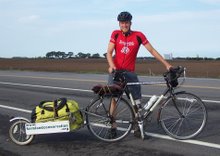We met at their house at
Tim was dressed in his characteristic coveralls and a plaid shirt. Before we stepped out
Washington is in Wilkes County so we drove through Winterville on our way over to 72 then took 72 through Crawford and Lexington and on for another 24 miles or so. On the drive over we talked a lot about the drought and how it had affected things. Tim and Alice have a 140 foot well that they water from, only the ground has shifted and lodge a solid rock into the shaft at about 40 feet. There’s still water at 40 feet but Tim talked about his idea to fire a rifle down the shaft to try and break up that rock. Their loyal and somewhat slow farm hand Paul is super excited about this idea.
Tim, Alice and Paul spent yesterday afternoon fishing up at the
This got us talking about feeding corn, and how I’d noticed that the supermarkets were advertising “All grain-fed” beef like that was a good thing or something. This conversation was interesting as Tim’s familiarity with the Bible had led him to believe that “fattening” the calf was a biblical instruction from God, that there was nothing wrong with that. We talked about how ruminant stomachs respond to grain and the problems with strains of e-coli that can now be passed from a cow to a human due to the acidic stomach of a cow from eating grain.
The Mule Day was a popular event with cars lined up at the entrance. There was a show ring and a mule drawn plough demo on one side and food and vendors on the other. The event was staged at the Callaway House historic preservation center, a great little locale with a beautiful, stately plantation style home with pillars and big front porch and one of the tallest, thickest southern magnolias I’ve ever seen. It was probably four feet across. They had reconstructed an 1889 one room schoolhouse as well. There was a sorghum mill and they were cooking up the sorghum syrup. This was neat to watch. There was brick fireplace, built of two long walls on top of which they sat a long iron flume. The sorghum syrup was moved from one section of the flume to the other depending on how long it had been cooking. As it was cooking a bright green film of chloroplast coagulated on the surface and was skimmed off. At the farthest end the syrup began to simmer and gain its characteristic dark color.

One of the things I enjoy the most from these type events it the opportunity to learn a few new terms. Of course, sometimes I have to relearn some old terms. The purpose of the event was to celebrate the mule and a mule simply put is the offspring of a male donkey and a female horse. It’s an F1 hyrbrid so to speak, and usually unable to reproduce. Before we left the house, Tim had explained that one of the advantages of the mule is that they will eat of lot of things that a horse will turn their nose up at. They seem to be hardier in that regard and not as prone to problems such as foundering. There are all types of mules, and as they moved about the show ring the judge explained a little about the cotton mule which was narrower and able to do delicate field work.

There were wagon rides, and tons of food. We walked over for lunch. I had a rib plate and enjoyed gnawing on the bones under the shade of a pine, wiping my face with white bread, interspersed with bites of beans and potato salad. Tim generously offered a delicious brownie with giant chunks of chocolate embedded. I also picked up a couple of three dollar pieces of pottery for Christmas presents.
On the way home I learned a little more about Tim and Alice’s history. They talked about their rodeo days, how every weekend for about 2-3 years they would travel to a rodeo where Tim would often ride the bulls.
They had moved to
When I first asked where they had lived when they arrived in
Tim was working on a piece of equipment inside the silage silo and got silage sickness, which can affect you if you breathe the fumes coming up out of the fermenting silage. The gas produced is nitrogen dioxide and kills people every year during the process of filling and maintaining silos. Tim went to the doctor and was told he had two choices. He could take one week of bed rest or he could go the hospital. Well the Mills had no health insurance, so bed rest seemed the way to go. Tim’s boss, Mr. Miller was a hard man and told him he could have the afternoon off but he expected him to be back the next day. Tim said that was not going to work. They spoke the next day and Mr. Miller told him to be back that day. No matter how many times Tim tried to explain to him how serious this was, they had reached an impasse. Tim did carpentry jobs for several months and the family moved into the trailer of a man and his daughter about Rebekah’s age. It worked for a short time but Tim and










